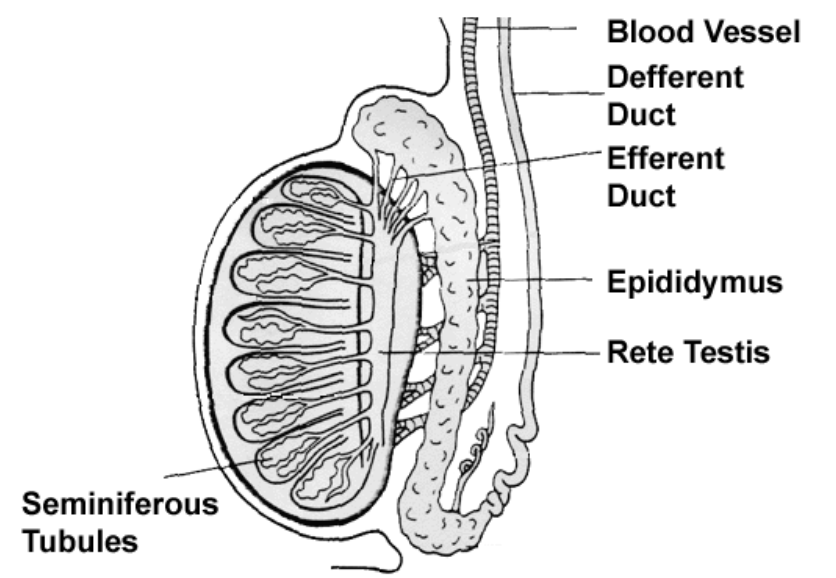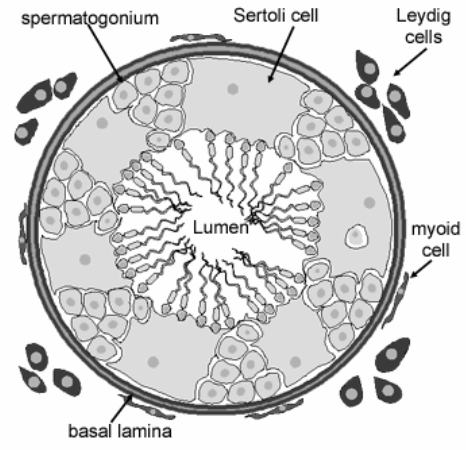
Answer
470.1k+ views
Hint: Seminiferous tubules are found inside the testes and are the basic location of meiosis and the subsequent development of male gametes, namely sperm cells.
Complete answer:
In the germinal epithelium of the seminiferous tubules, spermatozoa is formed and released into the lumina of these conduits. The germinal epithelium includes Sertoli cells as well as spermatocytes that form. Sertoli cells spread from the germinal epithelium's basement membrane to the tubule lumen. These cells surround the sperm cells that form. They are connected by junctional complexes and form the barrier of blood tests. There are clumps of darker eosinophilic cells in the interstitial space. They are the Leydig cells that create testosterone and release it. Myoid cells cover the tubules and trigger sperm and fluid rhythmic contractions.
Additional information:
Extremely convoluted tubes containing two distinct cell populations are seminiferous tubules. They are rich in spermatogenic and sertoli cells. The average length of these tubules is thirty centimeters and they rarely communicate with each other. In many mammals, the tubules are grouped into lobules separated by connective tissue septa or walls. The arrangement allows a large amount of germinal epithelium to be packed in a small space. In immature males and in adult males between breeding seasons, the tubules are inconspicuous and the epithelium is inactive; in some species, however, spermatogenesis or sperm production is variable throughout the year. Active epithelium may be present at all stages of sperm development.
Note: Seminiferous tubules may start at tunic or outermost layers of tissue and move on to the center and become tortuous before they are emptied into a system where the rete testis are collected.
Complete answer:
In the germinal epithelium of the seminiferous tubules, spermatozoa is formed and released into the lumina of these conduits. The germinal epithelium includes Sertoli cells as well as spermatocytes that form. Sertoli cells spread from the germinal epithelium's basement membrane to the tubule lumen. These cells surround the sperm cells that form. They are connected by junctional complexes and form the barrier of blood tests. There are clumps of darker eosinophilic cells in the interstitial space. They are the Leydig cells that create testosterone and release it. Myoid cells cover the tubules and trigger sperm and fluid rhythmic contractions.

| 
|
Additional information:
Extremely convoluted tubes containing two distinct cell populations are seminiferous tubules. They are rich in spermatogenic and sertoli cells. The average length of these tubules is thirty centimeters and they rarely communicate with each other. In many mammals, the tubules are grouped into lobules separated by connective tissue septa or walls. The arrangement allows a large amount of germinal epithelium to be packed in a small space. In immature males and in adult males between breeding seasons, the tubules are inconspicuous and the epithelium is inactive; in some species, however, spermatogenesis or sperm production is variable throughout the year. Active epithelium may be present at all stages of sperm development.
Note: Seminiferous tubules may start at tunic or outermost layers of tissue and move on to the center and become tortuous before they are emptied into a system where the rete testis are collected.
Recently Updated Pages
Find the real roots of the equation x2 f x 0 if fx-class-12-maths-CBSE

Find the principal value of tan 1left dfrac1sqrt 3 class 12 maths CBSE

Find the principal value of tan 1left 1 right class 12 maths CBSE

Find the principal value of sin 1left dfrac12 righ class 12 maths CBSE

Find the principal value of sin 1left cos dfrac3pi class 12 maths CBSE

Find the principal value of cot 1left dfrac1sqrt3 class 12 maths CBSE

Trending doubts
Which are the Top 10 Largest Countries of the World?

Differentiate between homogeneous and heterogeneous class 12 chemistry CBSE

Explain sex determination in humans with the help of class 12 biology CBSE

How much time does it take to bleed after eating p class 12 biology CBSE

Distinguish between asexual and sexual reproduction class 12 biology CBSE

Differentiate between insitu conservation and exsitu class 12 biology CBSE




